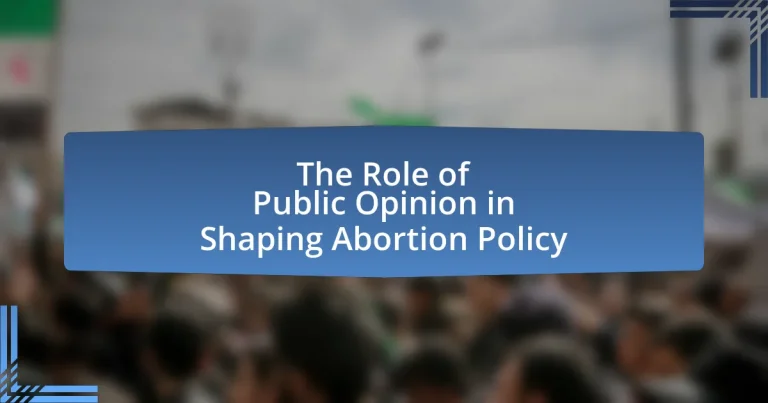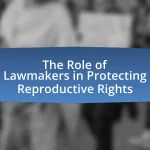The article examines the significant role of public opinion in shaping abortion policy, highlighting how societal attitudes influence legislative decisions and political discourse. It discusses key factors that shape public opinion, including demographic variables, political ideologies, and the impact of media portrayals and social movements. The article also explores historical examples of how public sentiment has led to changes in abortion laws, the methods used to gauge public opinion, and the challenges policymakers face when public opinion is divided. Overall, it underscores the dynamic relationship between public opinion and abortion policy, illustrating how shifts in societal attitudes can directly affect legislative outcomes and judicial decisions.
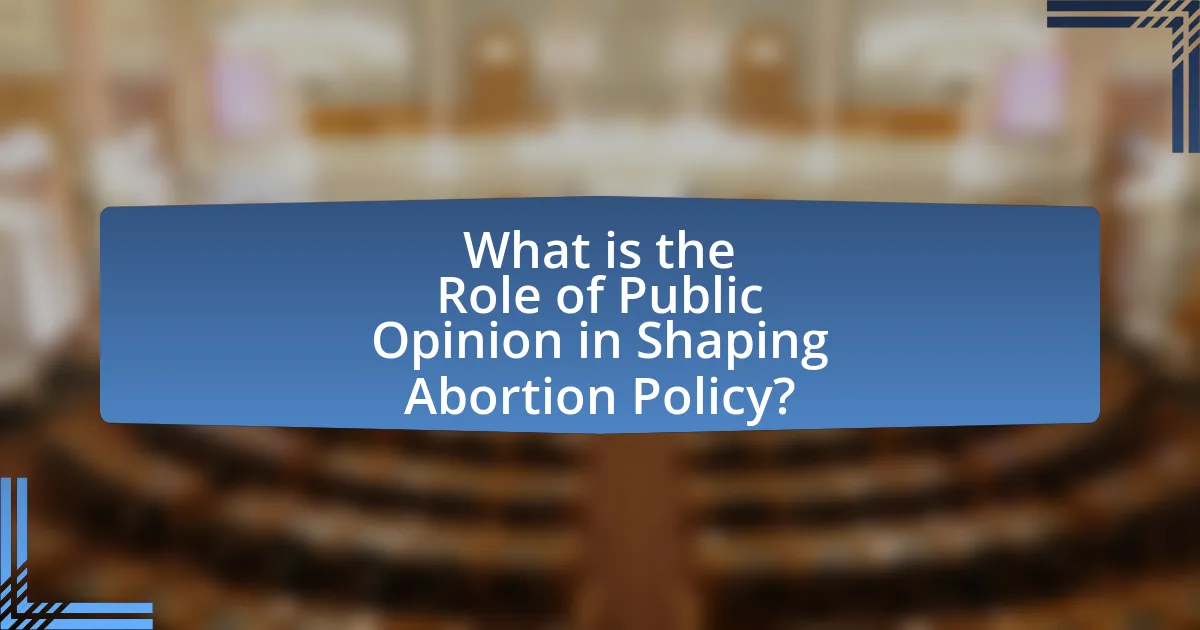
What is the Role of Public Opinion in Shaping Abortion Policy?
Public opinion plays a crucial role in shaping abortion policy by influencing lawmakers and public discourse. When a significant portion of the population expresses strong views on abortion, elected officials often respond to these sentiments to align with their constituents’ preferences, as seen in various polls indicating that public support for abortion rights has fluctuated over time. For instance, a Gallup poll from 2021 showed that 58% of Americans identified as pro-choice, which can lead to legislative actions that reflect this majority stance. Additionally, public opinion can mobilize advocacy groups, impacting policy through campaigns and lobbying efforts that push for or against specific abortion regulations.
How does public opinion influence legislative decisions on abortion?
Public opinion significantly influences legislative decisions on abortion by shaping the priorities and actions of elected officials. Legislators often respond to the views of their constituents to secure votes and maintain public support, leading them to align their policies with prevailing public sentiments. For instance, surveys indicate that a majority of Americans support legal access to abortion, which has prompted many lawmakers to advocate for reproductive rights. Conversely, in regions where opposition to abortion is strong, legislators may introduce restrictive laws to reflect the beliefs of their electorate. This dynamic is evident in the varying abortion laws across states, where public opinion directly correlates with legislative outcomes, demonstrating the power of societal attitudes in shaping abortion policy.
What are the key factors that shape public opinion on abortion?
Key factors that shape public opinion on abortion include religious beliefs, political affiliation, personal experiences, and demographic variables such as age and gender. Religious beliefs significantly influence individuals’ views, with more conservative faiths typically opposing abortion. Political affiliation also plays a crucial role; for instance, individuals identifying as Democrats are generally more supportive of abortion rights compared to Republicans. Personal experiences, such as having a friend or family member who has undergone an abortion, can alter perceptions and foster empathy. Additionally, demographic factors like age show that younger individuals tend to be more supportive of abortion rights, reflecting changing societal norms. These factors collectively contribute to the complex landscape of public opinion on abortion, as evidenced by various surveys and studies that highlight these correlations.
How do demographic variables affect public opinion regarding abortion?
Demographic variables significantly influence public opinion regarding abortion, with factors such as age, gender, race, education, and religious affiliation playing crucial roles. For instance, younger individuals tend to support abortion rights more than older generations, as evidenced by surveys indicating that 61% of those aged 18-29 favor legal abortion compared to 43% of those aged 65 and older. Gender also impacts views, with women generally more supportive of abortion rights than men; a 2021 Gallup poll showed that 61% of women identified as pro-choice versus 50% of men. Racial differences are evident as well, with Black and Hispanic populations often expressing more support for abortion access compared to white populations, reflecting broader social and economic contexts. Education level correlates with opinion, as higher educational attainment is associated with greater support for abortion rights; for example, 70% of college graduates support legal abortion compared to 50% of those with a high school education. Lastly, religious beliefs heavily influence perspectives, with more religious individuals typically opposing abortion; a Pew Research Center study found that 79% of weekly church attendees oppose abortion compared to 43% of those who seldom attend. These demographic factors collectively shape the landscape of public opinion on abortion, impacting policy discussions and legislative outcomes.
Why is public opinion important in the context of abortion policy?
Public opinion is crucial in the context of abortion policy because it directly influences legislative decisions and political agendas. Policymakers often consider the views of their constituents when formulating laws, as public support or opposition can determine the viability of proposed regulations. For instance, a Gallup poll from 2021 indicated that 58% of Americans identified as pro-choice, which can lead legislators to support more liberal abortion policies to align with the majority opinion. Additionally, public opinion can shape the political landscape, affecting election outcomes and the priorities of elected officials, thereby reinforcing the importance of societal attitudes in the ongoing debate over abortion rights.
What historical examples illustrate the impact of public opinion on abortion laws?
Public opinion has significantly influenced abortion laws throughout history, notably in the United States during the 1970s and 1980s. The landmark Supreme Court case Roe v. Wade in 1973 was largely a response to shifting public attitudes that favored legalizing abortion, as polls indicated that a majority of Americans supported a woman’s right to choose. Following this decision, public opinion continued to shape abortion policy, as seen in the 1989 case Webster v. Reproductive Health Services, where the Court upheld certain state restrictions on abortion, reflecting a growing anti-abortion sentiment among the public. Additionally, the 1992 case Planned Parenthood v. Casey reaffirmed Roe v. Wade but allowed states to impose regulations, demonstrating how public opinion can lead to more restrictive laws even after a precedent has been established. These examples illustrate the dynamic relationship between public sentiment and legislative action regarding abortion.
How do public opinion shifts correlate with changes in abortion policy?
Public opinion shifts significantly influence changes in abortion policy, as policymakers often respond to the prevailing views of their constituents. For instance, in the United States, a Gallup poll from 2021 indicated that 58% of Americans identified as pro-choice, reflecting a broader trend of increasing support for abortion rights over the past few decades. This shift in public sentiment has led to legislative changes in various states, such as the legalization of abortion in New York in 2019 and the expansion of access in several other states. Conversely, when public opinion leans towards restricting abortion, as seen in some regions, lawmakers may enact more restrictive laws, exemplified by the Texas Heartbeat Act in 2021, which was supported by a significant portion of the state’s population. Thus, the correlation between public opinion and abortion policy is evident, with shifts in societal attitudes directly impacting legislative actions.
What methods are used to gauge public opinion on abortion?
Surveys and polls are the primary methods used to gauge public opinion on abortion. These tools collect data from a representative sample of the population, allowing researchers to analyze attitudes and beliefs regarding abortion. For instance, organizations like Gallup and Pew Research regularly conduct national surveys that provide insights into public sentiment, revealing trends over time, such as the percentage of individuals who identify as pro-choice or pro-life. These findings are often reported in the media and can influence policymakers by reflecting the prevailing views of constituents.
What role do surveys and polls play in understanding public sentiment?
Surveys and polls are essential tools for gauging public sentiment, as they provide quantitative data on people’s opinions and attitudes. By systematically collecting responses from a representative sample of the population, these instruments reveal trends and shifts in public opinion over time. For instance, a Pew Research Center survey in 2021 indicated that 59% of Americans believed abortion should be legal in all or most cases, highlighting the prevailing attitudes that can influence policy decisions. This data-driven insight allows policymakers to align their decisions with the views of their constituents, thereby shaping abortion policy in accordance with public sentiment.
How do media portrayals influence public opinion on abortion?
Media portrayals significantly influence public opinion on abortion by shaping perceptions, framing narratives, and highlighting specific aspects of the issue. Research indicates that media coverage often emphasizes emotional stories, which can evoke strong reactions and sway public sentiment. For instance, a study published in the journal “Health Communication” found that exposure to media narratives about abortion can lead to increased empathy for individuals seeking abortions, thereby shifting public attitudes toward more supportive views. Additionally, the framing of abortion in media—whether as a health issue, a moral dilemma, or a women’s rights concern—can lead to varying levels of public support or opposition, as demonstrated by surveys conducted by organizations like the Pew Research Center, which show that framing can alter respondents’ opinions based on how the issue is presented.
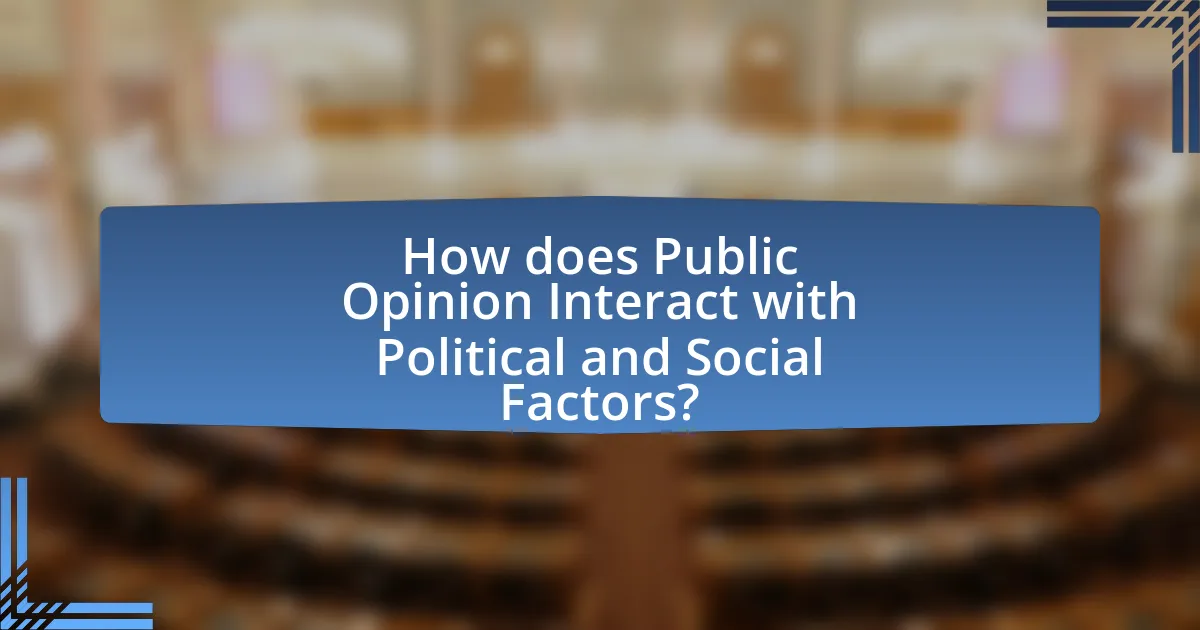
How does Public Opinion Interact with Political and Social Factors?
Public opinion interacts with political and social factors by influencing policy decisions and reflecting societal values. For instance, in the context of abortion policy, shifts in public sentiment can lead to changes in legislation, as seen in the United States where increasing support for abortion rights has prompted lawmakers to introduce more progressive policies. Additionally, social movements, such as those advocating for women’s rights, can mobilize public opinion, thereby pressuring political leaders to align their policies with the prevailing views of their constituents. This dynamic is evidenced by the 2020 Gallup poll, which indicated that 77% of Americans believed abortion should be legal in certain circumstances, showcasing how public opinion can shape political discourse and legislative action.
What political ideologies shape public opinion on abortion?
Political ideologies that shape public opinion on abortion include liberalism, conservatism, and feminism. Liberalism generally supports abortion rights, emphasizing individual autonomy and reproductive choice, which is reflected in public opinion polls showing higher support for abortion among liberal voters. Conservatism, on the other hand, often opposes abortion, advocating for traditional values and the protection of fetal life, leading to significant opposition among conservative demographics. Feminism contributes to the discourse by framing abortion as a critical issue of women’s rights and bodily autonomy, influencing public opinion through advocacy and activism. These ideologies interact with cultural, religious, and social factors, further shaping the diverse perspectives on abortion within society.
How do political parties leverage public opinion in their abortion policies?
Political parties leverage public opinion in their abortion policies by aligning their platforms with the prevailing attitudes of their constituents. For instance, surveys indicate that a significant portion of the American public supports legal access to abortion, which prompts parties to adopt pro-choice stances to attract voters. According to a 2021 Gallup poll, 58% of Americans identified as pro-choice, influencing Democratic candidates to emphasize reproductive rights in their campaigns. Conversely, Republican parties often highlight anti-abortion sentiments, reflecting the views of their base, where a 2020 Pew Research Center study found that 61% of white evangelical Protestants oppose abortion. By responding to these public opinions, political parties aim to mobilize their supporters and secure electoral success.
What role do interest groups play in shaping public perceptions of abortion?
Interest groups significantly influence public perceptions of abortion by advocating for specific viewpoints and mobilizing public opinion. These organizations, such as pro-choice and pro-life groups, utilize various strategies including lobbying, public campaigns, and social media outreach to disseminate their messages. For instance, the Guttmacher Institute reported that pro-choice organizations often emphasize women’s rights and health care access, while pro-life groups focus on fetal rights and moral arguments. This targeted messaging shapes how individuals perceive the issue, often polarizing public opinion and impacting legislative outcomes.
How does social media impact public opinion on abortion?
Social media significantly influences public opinion on abortion by facilitating the rapid dissemination of information and personal narratives. Platforms like Twitter and Facebook allow individuals and organizations to share their views, experiences, and research, which can shape perceptions and attitudes toward abortion. For instance, a study by the Pew Research Center found that 69% of Americans believe social media is an important source of information on political issues, including abortion. This accessibility enables diverse voices to contribute to the conversation, often leading to shifts in public sentiment as people engage with differing perspectives and data.
What are the effects of online activism on abortion-related public opinion?
Online activism significantly influences abortion-related public opinion by increasing awareness and mobilizing support for reproductive rights. Research indicates that social media campaigns, such as the #ShoutYourAbortion movement, have successfully destigmatized abortion and encouraged open discussions, leading to a more favorable public perception. A study published in the journal “Social Media + Society” found that online activism can shift attitudes, particularly among younger demographics, by providing relatable narratives and fostering community engagement. This shift in public opinion can ultimately impact policy decisions, as lawmakers often respond to changing societal attitudes regarding abortion.
How do social movements influence public attitudes towards abortion?
Social movements significantly influence public attitudes towards abortion by mobilizing individuals, shaping narratives, and advocating for policy changes. For instance, the pro-choice movement has utilized campaigns, protests, and educational initiatives to raise awareness about reproductive rights, thereby increasing public support for abortion access. Research indicates that states with active pro-choice movements tend to show higher levels of public support for abortion rights, as evidenced by a 2019 study published in the American Journal of Public Health, which found that public opinion shifted positively in states with organized advocacy efforts. Conversely, anti-abortion movements also impact public perception by framing abortion as a moral issue, leading to increased opposition in regions where these movements are prominent. This dynamic illustrates how social movements can effectively alter the landscape of public opinion on abortion through sustained activism and strategic communication.
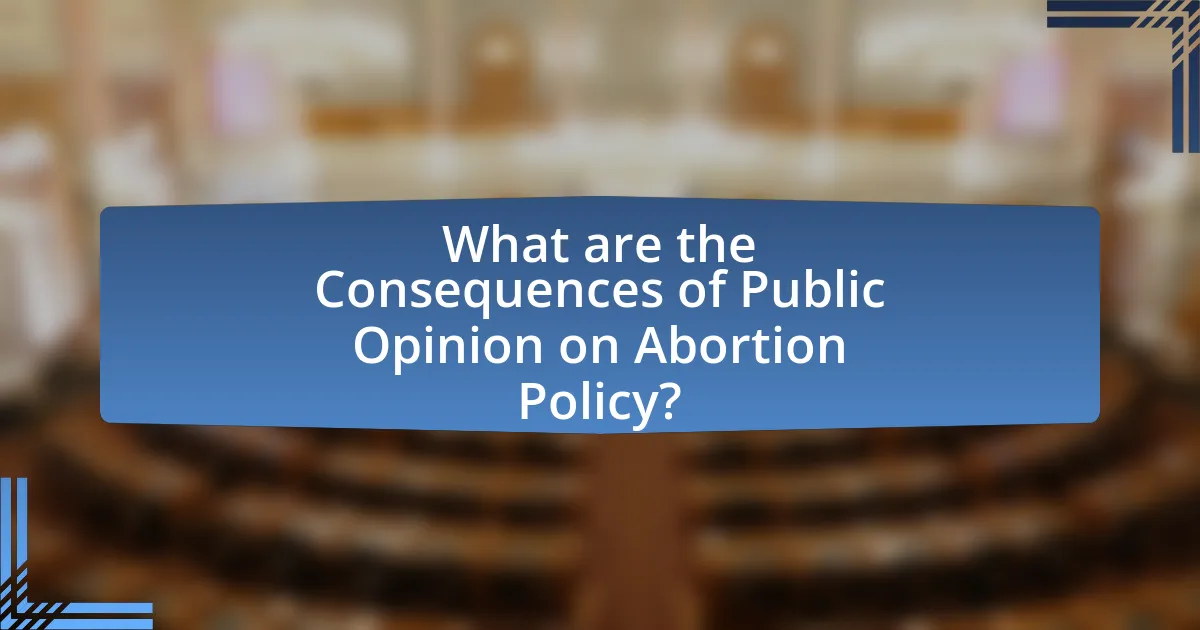
What are the Consequences of Public Opinion on Abortion Policy?
Public opinion significantly influences abortion policy by shaping legislative actions and judicial decisions. For instance, when public sentiment leans towards supporting abortion rights, lawmakers are more likely to propose and enact policies that protect access to abortion services. Conversely, when public opinion shifts towards opposition, it can lead to the introduction of restrictive laws, as seen in various states following the 2016 election, where many enacted laws limiting abortion access in response to perceived voter preferences. This dynamic illustrates how public opinion acts as a barometer for policymakers, often resulting in direct changes to abortion legislation and access based on prevailing societal attitudes.
How does public opinion affect the implementation of abortion laws?
Public opinion significantly influences the implementation of abortion laws by shaping political agendas and legislative actions. When a majority of the population supports or opposes abortion rights, elected officials often align their policies with these views to secure votes and maintain public approval. For instance, in the United States, surveys have shown that public sentiment on abortion has shifted over the years, impacting state-level legislation. According to a 2021 Gallup poll, 58% of Americans identified as pro-choice, which has led to the introduction and support of more liberal abortion laws in various states. Conversely, in regions where public opinion leans towards restricting abortion, lawmakers may enact more stringent regulations, reflecting the constituents’ preferences. This dynamic illustrates how public opinion serves as a critical driver in the legislative process surrounding abortion laws.
What challenges do policymakers face when public opinion is divided on abortion?
Policymakers face significant challenges when public opinion is divided on abortion, primarily due to conflicting societal values and the risk of political backlash. When constituents hold opposing views, policymakers must navigate a complex landscape where any decision may alienate a substantial portion of the electorate. For instance, a 2021 Gallup poll indicated that 49% of Americans identified as pro-choice while 47% identified as pro-life, highlighting the near-even split in public sentiment. This division complicates the policymaking process, as elected officials may struggle to create legislation that satisfies both sides while also adhering to their own beliefs and party lines. Additionally, divided public opinion can lead to increased polarization, making bipartisan support for any abortion-related policy more difficult to achieve.
How do public opinion trends affect judicial decisions regarding abortion rights?
Public opinion trends significantly influence judicial decisions regarding abortion rights by shaping the legal and political context in which courts operate. For instance, when public support for abortion rights increases, courts may be more inclined to uphold or expand access to abortion services, reflecting societal values. Historical examples include the Supreme Court’s decision in Roe v. Wade (1973), which was influenced by the growing public support for women’s rights and reproductive autonomy during the 1970s. Conversely, when public opinion shifts towards restricting abortion, as seen in recent years, courts may respond by upholding more restrictive laws, aligning judicial outcomes with prevailing societal attitudes. This dynamic illustrates how judicial decisions are not made in a vacuum but are responsive to the broader public sentiment surrounding abortion rights.
What strategies can advocates use to influence public opinion on abortion?
Advocates can influence public opinion on abortion through targeted messaging, grassroots mobilization, and leveraging social media platforms. Targeted messaging involves crafting narratives that resonate with specific demographics, utilizing emotional appeals and factual information to shape perceptions. Grassroots mobilization engages communities through events, discussions, and local campaigns, fostering personal connections and shared experiences that can shift opinions. Social media platforms serve as powerful tools for disseminating information rapidly, allowing advocates to reach wider audiences and engage in real-time discussions. For instance, studies show that social media campaigns can significantly increase awareness and support for abortion rights, as seen in the #ShoutYourAbortion movement, which encouraged individuals to share their stories and experiences.
What role does education play in shaping public attitudes towards abortion?
Education significantly influences public attitudes towards abortion by providing individuals with knowledge about reproductive health, rights, and the implications of abortion. Research indicates that higher levels of education correlate with more progressive views on abortion, as educated individuals are often more aware of the complexities surrounding the issue, including legal, ethical, and health-related aspects. For instance, a study published in the journal “Public Opinion Quarterly” found that individuals with college degrees are more likely to support abortion rights compared to those with only a high school education. This trend suggests that education fosters critical thinking and informed decision-making, which can lead to more supportive attitudes towards reproductive choices.
How can effective communication strategies alter public perceptions of abortion?
Effective communication strategies can significantly alter public perceptions of abortion by framing the issue in relatable terms and providing clear, factual information. For instance, campaigns that emphasize personal stories and the complexities surrounding abortion can humanize the issue, making it more relatable to the public. Research indicates that narratives can evoke empathy and shift attitudes; a study published in the journal “Health Communication” found that storytelling can lead to increased understanding and support for abortion rights among audiences who may initially oppose them. Additionally, using data-driven messaging that highlights the safety and necessity of abortion services can counteract misinformation and stigma, further influencing public opinion.
